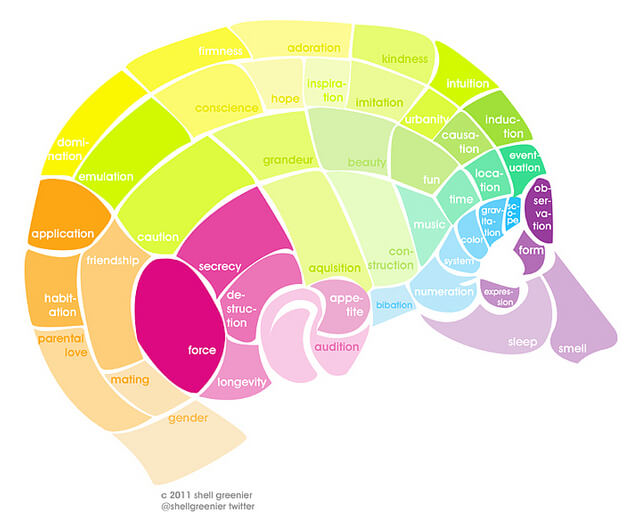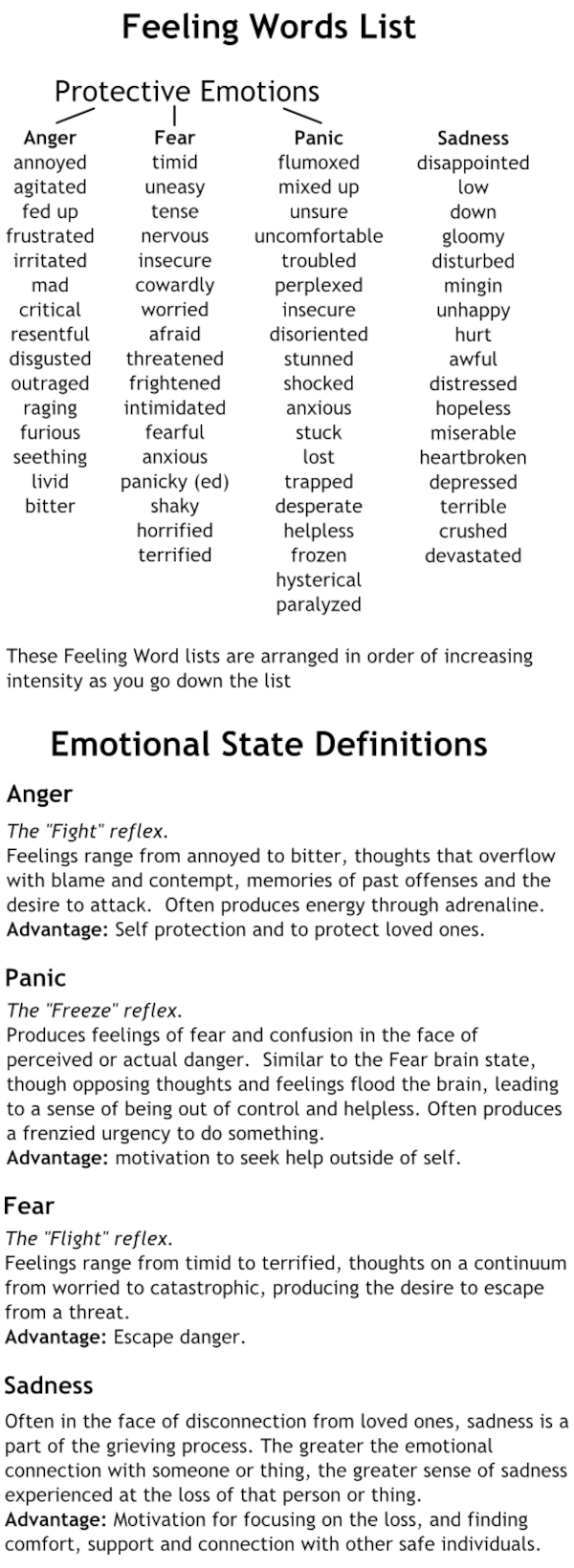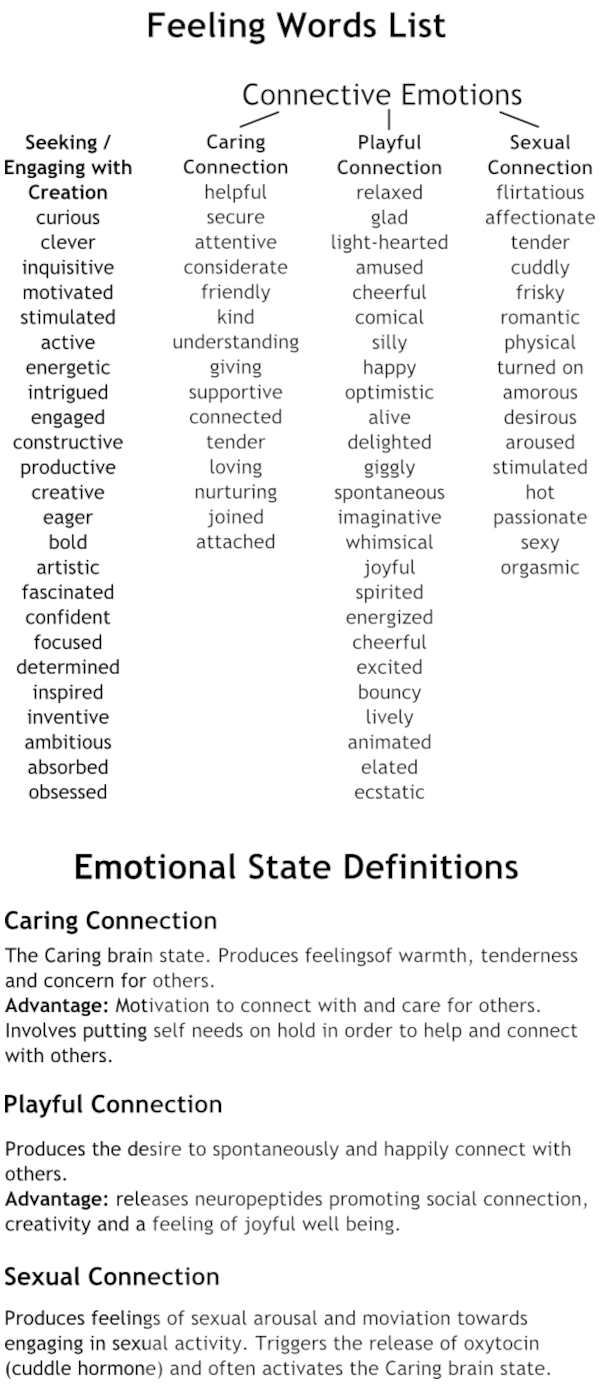Introduction
“Evidence is presented that the mass suppression of emotion throughout the civilized world has stifled our growth emotionally, leading us down a path of emotional ignorance.” - Ph.D. dissertation by Wayne Leon Payne. We live in a society that often finds it hard to express emotions, or on the other hand people express “out of control” emotions in a harmful way. As a result, it is difficult to know how to deal with our feelings appropriately. Emotional health is just as important as our physical health, making emotional intelligence vital. By it we understand ourselves, build self-confidence and empathetically relate to others.

This page introduces a framework for understanding emotions. In order to communicate about emotions, we need to know what words to use. We have produced a list of common emotion words and grouped them into Emotional Brain States. An Emotional Brain State is a hardwired circuit in our brain that based on stimuli perceived from the senses produces emotions, bodily (chemical) responses and sensations, and directs the body toward specific actions. Another way to understand an Emotional Brain State is to think of it being like a “Frame of Mind.” Have you heard someone say something like “I was in a state of shock”? or “let me wind down” or “change gears” after a tense day at work. These are all different ways we refer to our emotional states in normal conversation. We also have the ability to shift to another emotional brain state if it is more helpful for doing a different set of tasks. E.g. Someone may need to switch from a Seeking/Engaging brain state that was used while working on computer design to a Caring brain state before being able to have a conversation with a partner about his or her longings for greater intimacy.
Notice we mentioned, that the Emotional Brain States are hardwired in, meaning that everyone has these specific states. One author (Brent Atkinson) states that there are 7 emotional states. These are: Anger, Fear, Panic, Seeking, Caring Connection, Playful Connection, and Sexual Connection. The Anger, Fear, and Panic brain states are PROTECTIVE of self. The Caring, Playful, and Sexual brain states are CONNECTIVE with others. First, we want to be aware of these emotional states and understand what they are trying to accomplish for us. The easiest way to answer this is to say that the protective emotional states are informing us of a perceived danger or blocked goal. The connective states are informing us that there is an opportunity to bond with other people.
Protective Brain States
Here are lists of feeling words within each Protective Emotional Brain States followed by their definition. Many people refer to these as the “negative” emotions, which could have a connotation indicating that they are bad emotions, but it is our belief that every emotion has a purpose.
The emotional brain states lists are put in order of increasing intensity as you move down the list. One key purpose for understanding these emotional states is learning how to deal with the brain state while it is low in intensity before it grows “too intense” to be constructive.

Connective Brain States
Here are the Connective Emotional Brain States and the Seeking Brain State. Again as stated above about “negative” emotions, some people refer to the Connective Emotional Brain State as the “positive” emotions as if they always denote something good. We will argue that approaching conflict with friends or spouses should begin with a “Caring” or connective emotional state, but if the connective state is not being respected, it is appropriate to be angry or afraid and out of a protective state withdraw from the conflict for some time to “cool down”. We believe that most people quickly react out of protective states rather than speaking for what they want and this often hinders conflict resolution as both distance themselves in their protective defensive states. You can’t have resolution without some degree of connection.

The pie graph to the side shows the components of communication from Albert Mehrabian's studies. When communicating with another person, we do not just communicate using words. We also use tone and body language. The studies showed that the actual words we use are less significant than the tone and body language (including facial expression) in order to get the full message from the speaker.

Our emotions (emotional brain states) show in our body language and tone and we may end up communicating more through these than the actual words. We give the clearest communication when our words, tone, body language and facial expressions are all communicate the same message.
We encourage couples to shift out of protective brain states during conflict because research has shown that those who can shift out of protective brain states have greater success in relationships. See Brent Atkinson’s description of how emotional states control our brains rather than our thinking at times and how protective emotions hijack our communication.
Our goals in providing this tutorial have been to demonstrate to anyone how to perceive emotions, how to use your emotions, how to understand emotions and how to manage emotions in a way that is true to yourself and promotes bonding. Your ability to know and regulate your emotions will have a direct impact on the level of connection you share with your friends or romantic partner.
Self-Reflection Exercise
Ask yourself these questions about each of the Emotional Brain States:
- Are you aware of experiencing each of the Emotional Brain States from time to time?
- Do you recognize when this Emotional Brain state is up and running?
- How easily is each Emotional Brain State activated (triggered)?
- How do you feel when others try to understand and empathize with your feelings?
- How do you feel when others ignore, shame, tease, or try to “fix” your emotions?
- What levels of each brain state do you think are “appropriate” and should be expressed as normal?
- Think about this quote, “When I say manage emotions, I only mean the really distressing, incapacitating emotions. Feeling emotions is what makes life rich. You need your passions.” - Daniel Goleman
- Do you try to suppress any Emotional Brain States (e.g. anger or sadness) to avoid disconnection or vulnerability? If so, why?
- At what point does the Emotional Brain State no longer achieve what it was designed to be doing? (See the definitions of each brain state)
- Does this Emotional Brain State control you sometimes? How do you eventually shift out of the control of that Emotional Brain State?
- How do you feel when you notice this Emotional Brain State in your friend / family member / spouse?
- How do you react when others have these feelings?
- The aim is to remain in control of the Emotional Brain State and express the desires of that Emotional Brain State appropriately.
